|
|
 |
|
| SRI Fact Sheet - Andhra Pradesh |
|
| Total geographical area (km2) |
50,362 |
| Total population (million) |
24.4 |
| Total cultivable area (million ha) |
4.3 (2002-03) |
| Total paddy area (million ha) |
2.6 (2006-07) |
| Paddy area (%) to total cultivable area |
65 |
| Major rice season |
Kharif (Jun-Oct.) |
| Total paddy production (million tonnes) |
15.2 (2006-07) |
| State’s contribution to national paddy production (%) |
16.3 |
| Paddy productivity (t ha-1) |
5.8 (2006-07) |
| All-India rank in productivity |
1 |
| Constraints in paddy cultivation |
Water, labour, declining ground water levels and
pumping cost. |
|
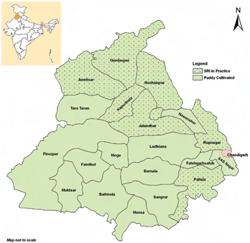 |
|
|
| |
|
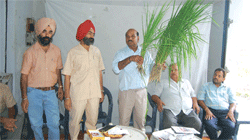 Background Background
Punjab is the bread basket of India. Wheat was the main crop until recently. Rice cultivation in Punjab is recent development. Availability of water, relatively rich soils, an innovative and hardworking farming community and market access have all contributed to the rapid growth of rice cultivation across Punjab. During 2006-07 the state cultivated 2.6 million ha of paddy (combined two crops), and produced 15.2 million tonnes. The area and production fluctuated in the last decade from 2.3 million ha to 2.6 million ha and 11.9 million tonnes to 15.7 million tonnes respectively. Average yields fluctuated from 4.7 t ha-1 to 5.9 t ha-1 (in 2006-07 it was 5.8 t ha-1) which is almost twice the national average.
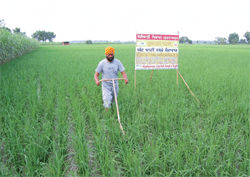 Punjab produces 16 percent of the nation's paddy and most of it is exported to other states and countries, therefore it has strategic impor tance in terms of food security and earning foreign exchange. Punjab produces 16 percent of the nation's paddy and most of it is exported to other states and countries, therefore it has strategic impor tance in terms of food security and earning foreign exchange.
However, rice cultivation is in big trouble in Punjab. Availability of water, which was actually the reason for the rapid growth of rice cultivation, has now become a major constraint. The situation is so bad that as of 2008, the Punjab government has imposed a total ban on rice transplantation in summer, the season with highest yield and profitability, to prevent fur ther decline of its ground water resources. Technology in pumping, electricity subsidy, lack of enforceable laws, lack of incentives to save water have all contributed to the rapid decline of ground water. In 2006, more than 30 per cent of farmerswere using centrifugal pumps sucking ground water from great depths (30 m). Electricity consumption in Punjab for agricultural pumps is about 7,500 million kWh. The total electrical subsidy for agricultural pumps amounted to Rs. 24,000 million (US$ 500 million), of that Rs. 15,000 million (US$ 300 million) was for rice cultivation. Punjab purchases electricity worth Rs. 28,000 million from other states and spends Rs. 1000 towards electricity subsidy per tonne of paddy production or Rs. 5,700 per hectare of paddy cultivation. This will go high in coming years, as the water table goes down further and power rates shoot up.
So, there is an urgent need to improve the water productivity of Punjab rice cultivation to prevent economic loss and ecological degradation. Preventing farmers from cultivating is not a viable option since it will have political, economic and social ramifications not only in Punjab but across India. The food security of India depends upon Punjab. Therefore, Punjab farmers need alternatives to produce more rice with less water. The System of Rice intensification (SRI) is one such option which is proving very cost-effective and is rapidly catching the imagination of the innovative Punjabi farmers.
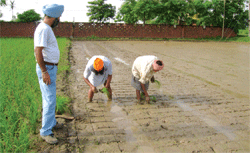 The entry of SRI into Punjab has an interesting story attached to it. Dr. Gurdial Singh, Joint Director, Department of Agriculture was introduced to the method in Hyderabad in 2005. After that, he along with a colleague Dr. Amrik Singh, established three small demonstration plots under Agricultural Technology Management Agency (ATMA) and CSS support of the Punjab state extension programme. The results were shared by two farmers and two officials at the first national symposium on SRI held in Hyderabad in 2006. There they also interacted with others practicing SRI and got some more information and encouragement. A remarkable story of individuals within the government system, who used their own initiative and worked hard with farmers to try and assess the SRI method, through initial field trials. In three years, from 10 farmers SRI is now being tried by 150 farmers. This year, in 2008, a total 225 acres of farmers' fields are under SRI in Gurdaspur district. A small area, but the results have attracted media, farmers and government officials to these SRI fields. The entry of SRI into Punjab has an interesting story attached to it. Dr. Gurdial Singh, Joint Director, Department of Agriculture was introduced to the method in Hyderabad in 2005. After that, he along with a colleague Dr. Amrik Singh, established three small demonstration plots under Agricultural Technology Management Agency (ATMA) and CSS support of the Punjab state extension programme. The results were shared by two farmers and two officials at the first national symposium on SRI held in Hyderabad in 2006. There they also interacted with others practicing SRI and got some more information and encouragement. A remarkable story of individuals within the government system, who used their own initiative and worked hard with farmers to try and assess the SRI method, through initial field trials. In three years, from 10 farmers SRI is now being tried by 150 farmers. This year, in 2008, a total 225 acres of farmers' fields are under SRI in Gurdaspur district. A small area, but the results have attracted media, farmers and government officials to these SRI fields.
Surely this is the beginning of the major transformation of rice cultivation in Punjab. It is hoped that SRI will be adopted by thousands of farmers next year after they interact, with farmers who now have experience and knowledge having successfully adopted the method.
|
| |
Performance
The results of farmer's field trials in 2007 are very convincing. The average yield increased from 7.7 t ha-1 to 9.8 t ha-1. The farmer's' net income increased from Rs.44,001 per ha to Rs. 58,818 per ha . The results are summarized in the table below. |
| |
| Table: Economics of SRI vs Conventional Method (kharif 2007) (Rupees) |
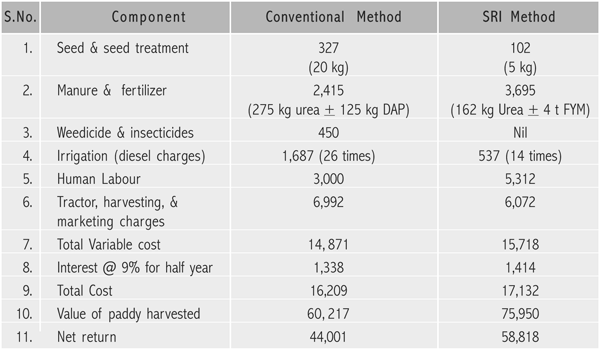 |
| |
Experiences in Adoption
Though SRI is in the initial stages, the farmers have responded very positively. Some issues related to its adoption are a) transplanting young seedlings b) draining of water from the field particularly when it is raining c) conoweeders, particularly the quality of the blades d) water-logging in low-lying areas e) availability of conoweeders. Many established institutions such as the Agricultural University, are reluctant to take up any research or promotion of SRI. The local government in Gurdaspur district, where the farmer field trials are being conducted, is very positive about SRI and is extending all support. |
| |
Way Forward
SRI is gaining momentous acceptance among Punjab farmers. In Gurdaspur district the experimental results
so far are very impressive.
Given the major challenge for the government of Punjab - an alarming water crisis that is expected to further escalate due to climate change - what Punjab requires immediately is an ecologically sustainable and innovative approach, which will provide farmers the option of cultivation with greater yield and profits.
As mentioned above, the government of Punjab took some drastic steps last year: it banned rice cultivation in summer. The government is even reported to have taken serious measures against farmers who violated this order. Certainly the measure adopted is no solution and farmers are very unhappy.
Punjab has great opportunity to promote SRI. Punjab farmers in Gurdaspur and officials in the district are very receptive to this method. But in order to see the benefit of SRI - both increasing the production of rice in Punjab and significant reduction pressure on water resource, particularly during summer time - Punjab needs to adopt SRI on a large scale. And for that, the following specific support measures are required from the higher authorities: |
|
| |
|
|
| |
|